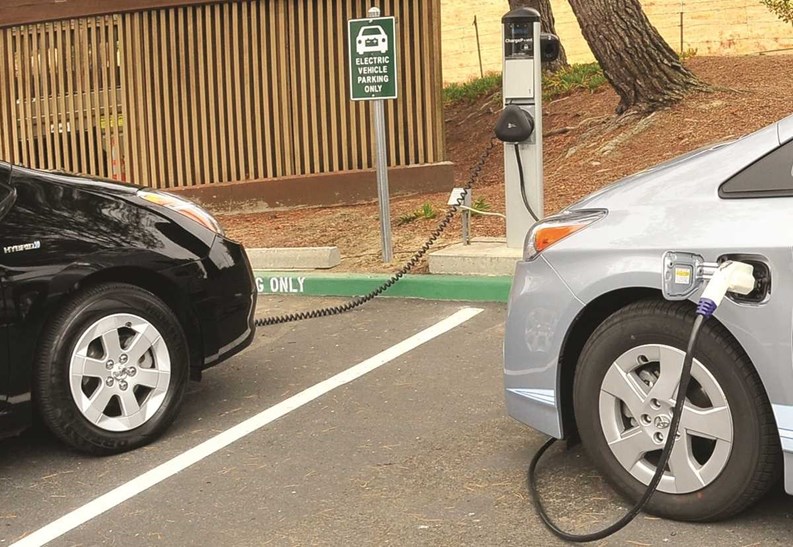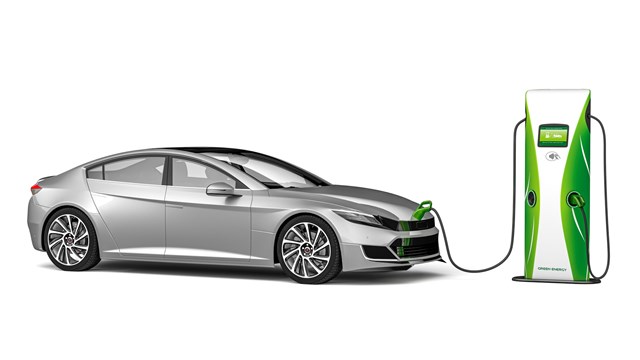Whether condo associations will buy into the so-called “electric highway” has become the perennial $64,000 question.
And the answer? Maybe — eventually.
The demand isn’t there yet, but just how fast this wave of the future is traveling remains unknown. Board members would be wise to explore the trend now, before greenhouse gas laws overtake them.
Thanks to its climate, New England trails behind in EV (electric vehicle) use and services. Cold weather reduces the driving range of these vehicles, so condominium managers haven’t exactly needed to consider the technology. Many say there are fewer than a handful of these vehicles on site.
What they should consider is the rate and direction of sales. While plug-in cars lag here, they are increasing (see sidebar). Still, less than 10 percent of about 53,000 plug-in vehicles sold in the U.S. during 2012 were in this region; Green Car Reports, an online newsletter of smart car use, says fewer than 750 public charging stations exist in New England. The states are, however rapidly moving in this direction.
And across the country, demand for hybrids and electric vehicles has been weaker than expected. Last year, nearly 488,000 hybrids, plug-in hybrids and electric cars were sold in the United States, accounting for 3.3 percent of the overall auto market, according to green-car website Hybridcars.com. For the Obama administration to meet its 2015 goal, electrified vehicles would have double their market share to roughly 6 percent of the U.S. auto market, which automotive consulting firm Polk estimates will reach 16.2 million vehicles that year.
Over time, though, the demand for charging services at home will increase, and network providers are coordinating efforts to meet demand. Northeast Utilities has combined efforts of electric providers and green organizations in Connecticut and western Massachusetts to build a network of charging stations in public/private settings. “There is a growing network, and a growing interest, in the cars,” reports Linda Benevides of Massachusetts’ Executive Office of Energy and Environmental Affairs. “Working with our cities and towns, the Mass Clean Cities Program paid for 155 charging stations to be placed in optimal public locations throughout the state … parking garages, malls, Logan Airport and MBTA parking areas.”
According to Anne Smith, director of public relations and communications for ChargePoint, which provides an online network of EV charging stations, Massachusetts has 1,432 registered EV drivers followed by 798 in Connecticut, 316 in New Hampshire, 275 in Maine, 201 in Vermont, and 138 in Rhode Island. Also Massachusetts leads the way with 208 charging stations.
One wonders how board members will handle the cost of electric charging stations for residents, and just who will pay the cost for the electricity they consume. At present, owners either plug in overnight in their garages or use public stations, like the six Level 2 parking slots at the MBTA’s Alewife station.
At some point, condominium owners and developers may decide to install charging stations, but right now, it’s difficult to find condominiums with charging stations here. For condos, however, being “smart” may become a calling card.
“They would be viewed as sustainable,” says Benevides. “Many urban, young professionals are interested in these vehicles and would view the charging options as a valuable asset, driving them to purchase or rent. Also, the ‘silver tsunami’—a.k.a. aging baby boomers—who may have money and are downsizing will see charging stations at condos as a luxury, too. But the bottom line is, electric-car friendly (condo) associations would accommodate occupants and attract the public that is more and more conscious of minimizing their impact on the environment.”
Heat and air conditioning draw from the vehicle battery, resulting in a more frequent need to charge, but interest increases, regardless; “buyers will simply use the car when it’s appropriate,” says Carly Kade, communications manager for eVgo Communications of Houston, Texas. She says consumers buy a car appropriate for travel on average days, regardless of where they live. According to eVgo, dedicated chargers for multi-family buildings are one of four primary needs for EV drivers (the others being range confidence (mileage per charge); standardized, transparent costs; and low upfront cost).
Plugging In
Managers say they still haven’t heard it from residents, though. In some cases, residents simply plug into their own charging station—a 110-volt outlet in the garage attached to their unit—and their electricity bill. An overnight charge is sufficient for daily use.
That’s the case at Ridgefield Condominiums in Clinton, Massachusetts, where some 360 residents in 95 buildings each have a garage. The only charging station, says Lauren Richards, property manager at Ridgefield, is used by management: “We have a maintenance building where we put in a power charge to do that for ours. There’s no demand for anything additional at the moment. People do have hybrid cars here, but nobody’s asking for charging stations.”
Jennifer Coa, property manager at Union Crossing in Lawrence, Massachusetts, a converted mill now housing multiple apartments, says residents haven’t requested it. “I haven’t even seen any electric vehicles in the parking lots,” she said.
Tim Cannon, who works in apartment leasing at Third Square, a 485-unit community in Cambridge, says charging stations are here to stay. He notes a lot of inquiries from people interested in green living—from recycling to electric stations. But while the expectation is there, actual users are not. Third Square’s two modest charging stations don’t cost residents much to use (about $2 a charge, he estimates), and they aren’t used daily yet. But potential dwellers are beginning to expect these features, so “any of the new properties will feature them.”
California condo boards balked at installing stations until the law prodded them. The Luskin Center for Innovative Research at UCLA reports the boards dislike the cost of installing charging stations, which may vary from a low of $3,000 up to $15,000—especially when Level 1 is essentially the equivalent of running an extension cord from the dwelling.
New England boards should prepare. “The government is investing heavily in renewable energy, including electromobility,” Massachusetts’ Benevides says. “One of the climate change policies the state is working on is to increase the use of ‘zero-emission vehicles’ as well as compressed natural gas, propane and fuel-efficient vehicles. So we are working hard to take appropriate government actions, such as requiring that manufacturers sell an increasing percentage of zero-emission vehicles in Massachusetts and conducting activities that inform potential owners of the benefits.” These policies parallel what’s going on across the New England states.
“Evidence from around the country is that 80 percent of the charging occurs at home (with about 10 percent at the workplace and 10 percent at public locations),” Benevides said. “So charging in multi-family homes and condominium or apartment complexes is very important and something that we will be working on this year.”
Not everyone is convinced.
EVs on the Horizon?
“While there is a lot of talk these days about ‘going green,’ the reality is probably closer to the fact that electric vehicles still cost more to own and operate and are less convenient, so there is not the great push that a lot of people hoped there would be,” said Russ Fernandes, principal/senior vice president of Becht Engineering BT, Inc., in Boston. “Also, as long as the electricity that we produce as a nation is predominantly produced by coal or oil-fired generating plants, I question whether the electricity that these cars require doesn’t actually result in more pollution being generated than that of an efficient gasoline-powered vehicle, on a pollution-per-mile basis.
“It comes down to supply and demand, and right now I do not believe there is sufficient demand for these types of facilities, because there isn’t that great a demand for the vehicles,” said Fernandes. “In all likelihood, it will take a major disruption/cost spike in the fuel supply to make much of a change in the situation.”
Yes, and no. Analysts say the price will go down, making EVs more tempting, and while it’s true that electricity depends on coal-fired technology, there’s less pollution on the user end of the relationship.
“We very much think EVs are critical to meeting our commitments to greenhouse gas reductions and the around 40-mile range makes sense for a lot of the driving public,” Benevides said. “We don't want to build out the public charging network and not follow up on workplace and home charging at residential developments.”
Unless residents want to look at electric cords hanging over patio walls, charging stations may be imperative as usage grows. Fortunately, the federal government is offering incentives to assist with installation.
Suzanne Tamargo, spokeswoman for the nationwide service Car Charging—the provider for Walgreen’s stations (the chain has installed public stations at many of its urban locations)—says that, while condominium associations may or may not charge, most public facilities have some kind of fee, even if it’s only for using the parking space allotted to a charging station. Some places charge by time, others by unit of energy—about 49 cents per kilowatt hour.
Boards will have to consider the cost if they do install chargers, and determine how non-electric car users fit in. The cost of supplying electricity varies, but typically runs about 50 cents to 75 cents an hour, according to Pike Research/Energy Market Intelligence.
“Most of the charging technology is built into the car itself,” says Paul Wessel with the Connecticut-based Green Parking Council. “A Level 1 charging station is just a regular outlet. A Level 2 station is a fancy 240-volt outlet—like an electric dryer hookup. Installing electric vehicle chargers in most cases doesn’t even require a special permit beyond what one would need to install these outlets.”
Ah, yes. But consider: “Installation of charging stations in and for multi-dwelling units presents challenges, including restrictions on use of common property, parking that may be remote from power sources (that will add to the cost of installation), lack of designated parking for EV owners and how to allocate costs to specific residents who own the vehicles to be charged, instead of all residents,” said Benevides. “There are some best practices that we have seen from other parts of the country and we will be testing those in Massachusetts.”
Whose Place is It?
And, according to eVgo’s Kade, another challenge for condominiums stems from parking spaces being deeded to individual owners. “We choose to deploy chargers in groups to keep the cost of the infrastructure as low as possible,” she says. “Therefore, we need to designate parking spaces that are not deeded, or where the HOA is willing to relocate existing parking assignments… We have had success in condominiums where they were willing to provide non-deeded space.”
J.R. DeShazo, director of the Luskin Center for Innovation at UCLA, says boards can take the simplest approach first. “Using what they already have is the smartest thing, and the cheapest thing, they can do. If there are 110-volt outlets, just utilize them. People can do that with a wall plug, and 95 percent of the vehicles will fully recharge overnight. Ten hours will give you 100 miles, so if you’re driving less than 60 miles a day, that’ll be fine.”
At Level 2, costs can become “challenging.” DeShazo dubs this the battleground for condo boards, saying, “You might have to run wiring in an existing building.” He prefers that new installations or retrofitting existing buildings offer conduits for electric charging, in case it is ever needed. Also, local building codes may need to be changed.
DeShazo also suggests condo boards can reassign parking spots so that electric vehicles will be close enough to use existing Level 1 plug-ins. “If that doesn’t work, then the ideal is to consider the building type, codes, etc., to see if it will allow residents to install their own charging space, and if possible pay the electric bill. It’s ideal to connect to an existing meter, but they might get two bills instead.”
Why should condo boards consider this? DeShazo says it’s mainly to be progressive and environmentally-friendly. “We (in California) have about 45,000 EVs on our roads. So some buildings are marketing themselves as EV-friendly or EV-ready, meaning they have a unit with at least a 110-volt outlet. Condos tend to be really conservative. It’s hard to get them to do it … but being EV-friendly becomes simply another amenity they need to provide. Many make the investment and then figure out cost recovery.”
Just to be on the safe side, associations should hire an electrician with experience at putting in the charging equipment, he says. In New England, older buildings are under-powered, so they don’t have enough juice for all of these technical innovations; they might have to install energy-efficient lighting to free up electricity to put in the chargers.
Ann Frantz is a Massachusetts freelance writer and a frequent contributor to New England Condominium.







Comments
Leave a Comment